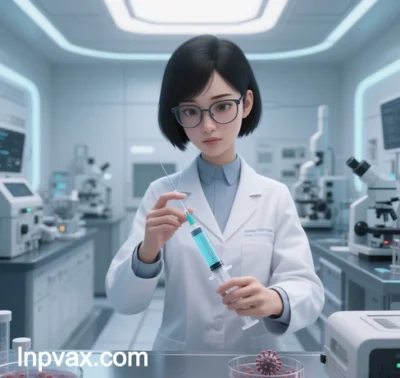
LNP-Vax: Core Concepts and Technical Principles
LNP-Vax (Lipid Nanoparticle-based Vaccine) is a vaccine technology centered on lipid nanoparticles (LNPs) as a delivery system. Its essence lies in encapsulating nucleic acids (e.g., mRNA, siRNA) or antigens within LNPs to achieve efficient, targeted immune activation. While widely recognized for its breakthrough role in COVID-19 mRNA vaccines, its potential extends to gene therapy, cancer vaccines, and genetic disorder interventions. Below is a systematic analysis of its core definitions, technical principles, breakthroughs, and challenges.
I. Core Concepts: The Essence and Function of LNP-Vax
- Definition:
LNP-Vax refers to vaccines or therapeutics developed using LNP delivery platforms, with core functionalities including:- Nucleic Acid Protection: Shielding labile nucleic acids (e.g., mRNA/siRNA) from enzymatic degradation.
- Targeted Delivery: Directing therapeutics to specific tissues (e.g., hepatocytes, immune cells) via lipid composition and surface modifications.
- Controlled Release: Triggering nucleic acid release in specific cellular environments (e.g., low-pH endosomes) through lipid phase transitions.
- Applications:
- Infectious Disease Vaccines: COVID-19 mRNA vaccines (e.g., Pfizer/BioNTech’s BNT162b2, Moderna’s mRNA-1273).
- Cancer Immunotherapy: Delivering tumor antigen mRNA or immune modulators (e.g., PD-1 antibody-encoding mRNA).
- Gene Editing: Packaging CRISPR-Cas9 systems for in vivo gene correction (e.g., Intellia’s NTLA-2001).
II. Technical Principles: Scientific Mechanisms of LNP Delivery
The LNP-Vax framework encompasses three dimensions: structural design, delivery mechanisms, and manufacturing processes.
- Structural Composition and Function:
LNPs consist of four key lipid types in specific ratios:Lipid Type Function Examples Ionizable Cationic Lipids Positively charged in acidic endosomes to promote nucleic acid release; neutral at physiological pH to reduce toxicity. ALC-0315 (Moderna), DLin-MC3-DMA (Pfizer) Cholesterol Stabilizes particles and modulates membrane fluidity. Natural cholesterol Helper Phospholipids Maintain bilayer structure and assist membrane fusion. DSPC (Distearoylphosphatidylcholine) PEGylated Lipids Control particle size, reduce immune recognition, and prolong circulation. DMG-PEG 2000 Note: Lipid ratios critically influence LNP size, stability, and targeting. Excessive PEGylated lipids can inhibit cellular uptake.
- Delivery Mechanism: From Extracellular to Intracellular Release:
- Cellular Uptake: Relies on endocytosis (e.g., clathrin-mediated), where LNPs enter the cytoplasm via membrane fusion or endosomal escape.
- Endosomal Escape: Ionizable lipids protonate in acidic endosomes, disrupting endosomal membranes to release nucleic acids (escape efficiency remains a bottleneck).
- Immune Activation: LNPs stimulate pattern recognition receptors (e.g., TLRs), enhancing adjuvant effects but requiring balance to avoid excessive inflammation.
- Manufacturing Processes: Lab to Industry:
- Microfluidic Mixing: Precise control of lipid-to-nucleic acid flow ratios produces uniform LNPs (size <100 nm, PDI <0.2).
- Continuous Production: Turbulent jet mixers (e.g., Knauer Impingement Jet Mixer) enable high-throughput, low-cost clinical-scale manufacturing.
- Lyophilization: Cryoprotectants (e.g., trehalose) stabilize LNPs at room temperature for ≥12 months, bypassing cold-chain requirements.
III. Key Breakthroughs: Milestones in LNP-Vax Development
- Ionizable Lipid Innovations:
- DLin-MC3-DMA: Pioneered efficient siRNA delivery, ushering in LNP-based therapies.
- ALC-0315/SM-102: Optimized pKa (~6.7) to balance nucleic acid encapsulation and endosomal escape, becoming the “gold standard” for COVID-19 mRNA vaccines.
- Targeting Strategies:
- Liver Targeting: Natural LNP tropism for hepatocytes enables treatments for liver diseases (e.g., α1-antitrypsin deficiency).
- Beyond the Liver: Surface conjugation of transferrin receptor antibodies facilitates blood-brain barrier penetration for neurodegenerative diseases; lung-targeted lipids (e.g., DLin-M-KE100) treat cystic fibrosis.
- Immunogenicity Control:
- Non-PEG Alternatives: Polysarcosine-modified lipids avoid anti-PEG antibody reactions (pre-existing in ~30% of the population).
- Stealth Lipids: “Invisible lipids” reduce complement activation and infusion-related reactions.
IV. Challenges and Future Directions
- Current Technical Hurdles:
- Delivery Efficiency: <5% endosomal escape rates demand novel lipids (e.g., membrane-penetrating peptide fusions).
- Targeting Limitations: Intravenous LNPs predominantly accumulate in the liver; organ-specific lipid libraries (e.g., AI-predicted lung/cardiac lipids) are needed.
- Scalability Costs: Cationic lipid reliance on single suppliers (e.g., Merck) poses supply risks; CRDMOs drive localized production.
- Innovative Pathways:
- Modular Platforms: “Plug-and-play” lipid libraries for rapid customization of targeting, release kinetics (e.g., light-controlled release).
- Exosome-LNP Hybrids: Merge exosomes’ natural homing with LNP drug-loading capacity to enhance tumor targeting.
- AI-Driven Design: Deep learning models predict lipid-receptor interactions, accelerating ionizable lipid discovery.
- Regulatory and Industry Alignment:
- Global Standards: FDA-EMA collaboration on LNP guidelines (e.g., USP <1040>) to streamline international submissions.
- Low-Cost Solutions: Paper-based microfluidics and 3D-printed dispensing devices to democratize LNP access in low-resource regions.
V. Conclusion
LNP-Vax represents a paradigm shift in nucleic acid delivery, combining lipid chemistry and nanoengineering to precisely control therapeutics. Despite challenges in delivery efficiency, targeting, and immunogenicity, advancements in ionizable lipids, AI optimization, and scalable manufacturing position LNP-Vax as a cornerstone of gene therapy, cancer immunotherapy, and global public health. Moving forward, technological progress must align with ethical frameworks to ensure equitable access to these transformative therapies.
Data sourced from public references. For collaboration or domain inquiries, contact: chuanchuan810@gmail.com





